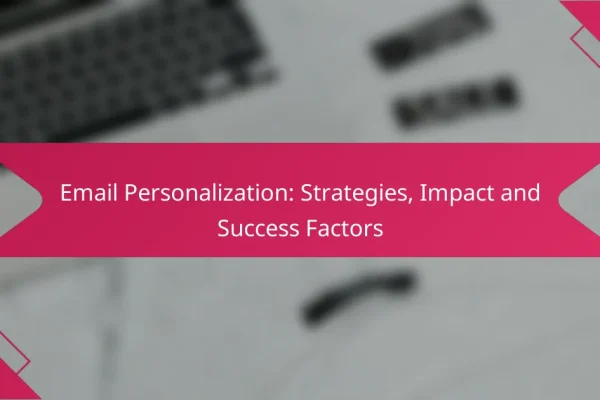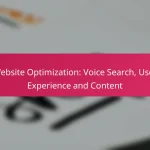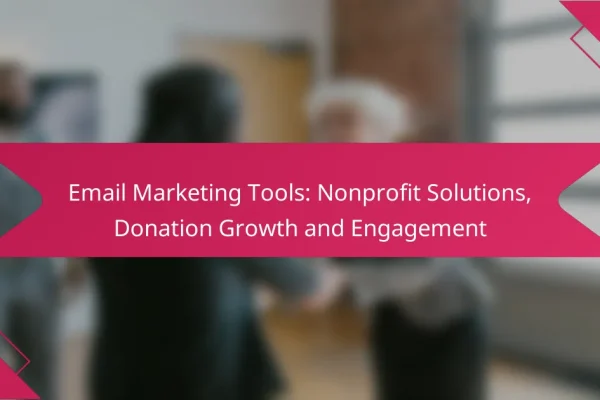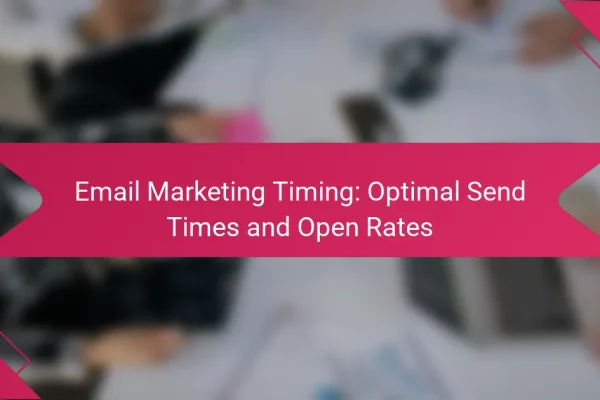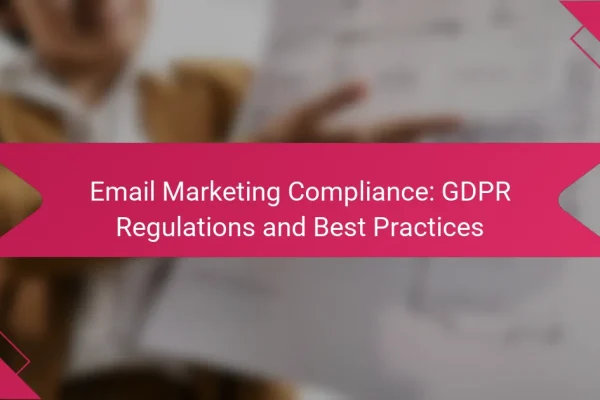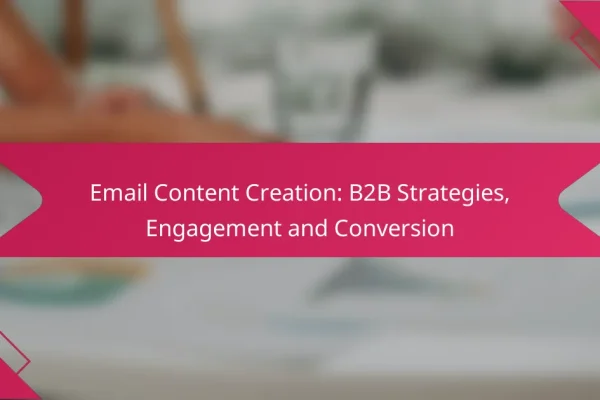What email marketing techniques drive higher conversions in Canada?
Email marketing techniques that drive higher conversions in Canada include personalization, segmentation, A/B testing, effective subject lines, and optimized calls-to-action. These strategies help businesses connect with their audience more effectively, leading to increased engagement and sales.
Personalization strategies
Personalization involves tailoring email content to individual recipients based on their preferences, behaviors, and demographics. In Canada, using the recipient’s name and recommending products based on past purchases can significantly enhance engagement rates.
Consider utilizing dynamic content that changes based on user data. For example, sending targeted offers during local holidays or events can resonate more with Canadian consumers, making them feel valued and understood.
Segmentation methods
Segmentation involves dividing your email list into smaller groups based on specific criteria such as age, location, or purchase history. This allows for more relevant messaging, which can lead to higher conversion rates.
In Canada, consider segmenting by language preference (English or French) to cater to diverse audiences. Additionally, targeting segments based on seasonal buying patterns can optimize your campaigns for maximum effectiveness.
A/B testing approaches
A/B testing, or split testing, is a method where two versions of an email are sent to different segments to determine which performs better. This technique helps refine your email marketing strategy by identifying what resonates with your audience.
Test various elements such as subject lines, images, and call-to-action buttons. For instance, you might find that a more straightforward subject line leads to higher open rates among Canadian consumers compared to a more creative one.
Effective subject lines
Crafting effective subject lines is crucial for improving open rates. A compelling subject line should be concise, relevant, and evoke curiosity or urgency.
In Canada, consider including localized references or seasonal themes, such as “Celebrate Canada Day with 20% Off!” This approach can create a sense of relevance and prompt recipients to open the email.
Call-to-action optimization
Optimizing your call-to-action (CTA) is essential for guiding recipients toward desired actions, such as making a purchase or signing up for a webinar. A clear and compelling CTA can significantly boost conversion rates.
Use action-oriented language and ensure your CTA stands out visually. For example, instead of a generic “Click Here,” use “Get Your Free Trial Now!” This specificity can motivate Canadian consumers to take immediate action.
How can segmentation improve email marketing effectiveness?
Segmentation enhances email marketing effectiveness by allowing marketers to tailor messages to specific audience groups, leading to higher engagement and conversion rates. By dividing your audience based on shared characteristics, you can deliver more relevant content that resonates with each segment.
Demographic segmentation
Demographic segmentation involves categorizing your email list based on characteristics such as age, gender, income, and education level. This approach helps you create targeted campaigns that speak directly to the interests and needs of different demographic groups.
For example, a luxury brand may focus on high-income individuals, while a student discount service targets younger audiences. Understanding these demographics can guide your messaging and promotional offers to increase relevance and response rates.
Behavioral segmentation
Behavioral segmentation classifies subscribers based on their interactions with your emails and website, such as purchase history, browsing habits, and engagement levels. This method allows you to tailor content based on how customers have previously responded to your marketing efforts.
For instance, you can send re-engagement emails to inactive users or personalized product recommendations to frequent buyers. By aligning your messaging with user behavior, you can significantly boost conversion rates.
Geographic segmentation
Geographic segmentation divides your audience based on their physical location, which can influence purchasing behavior and preferences. This approach is particularly useful for businesses operating in multiple regions or countries, as it allows for localized marketing strategies.
For example, a retailer might promote winter clothing in colder regions while advertising summer apparel in warmer areas. Additionally, considering local holidays or events can enhance the relevance of your campaigns, making them more appealing to specific geographic audiences.
What role does A/B testing play in email campaigns?
A/B testing is crucial for optimizing email campaigns as it allows marketers to compare different versions of emails to see which performs better. By testing elements like subject lines, layouts, and send times, businesses can make data-driven decisions that enhance engagement and conversion rates.
Testing subject lines
Subject lines significantly impact open rates, making them a prime candidate for A/B testing. Consider testing variations in length, tone, and personalization. For example, a subject line with the recipient’s name may outperform a generic one by several percentage points.
When testing, aim for a sample size that provides statistically significant results, typically a few hundred recipients per variant. Track metrics such as open rates and click-through rates to determine the most effective subject lines.
Testing email layouts
Email layout influences how recipients interact with content. A/B testing different layouts can reveal which designs lead to higher engagement. For instance, a single-column layout may work better for mobile users, while multi-column designs might suit desktop users.
Focus on elements like image placement, call-to-action (CTA) buttons, and text formatting. Test variations by changing one element at a time to isolate the impact of each change, and analyze user behavior to refine your approach.
Testing send times
The timing of your email can greatly affect its performance. A/B testing different send times helps identify when your audience is most likely to engage. Common strategies include testing weekdays versus weekends or different times of day.
Consider your audience’s habits and preferences when selecting test times. For example, if your target demographic is working professionals, sending emails during lunch hours or early evenings may yield better results. Track open and click rates to find the optimal sending window for your campaigns.
What are the best practices for crafting engaging subject lines?
Engaging subject lines are crucial for improving email marketing conversions. They should capture attention and encourage recipients to open the email, leading to higher engagement rates.
Using urgency and scarcity
Creating a sense of urgency or scarcity can significantly boost open rates. Phrases like “limited time offer” or “only a few spots left” prompt recipients to act quickly, reducing the likelihood of procrastination.
To implement this, consider time-sensitive promotions or exclusive deals. For instance, “Flash Sale: 24 Hours Only!” can compel immediate action, while “Last Chance to Register!” can drive urgency for events.
Incorporating personalization
Personalized subject lines can enhance engagement by making recipients feel valued. Using their name or referencing past purchases can create a connection that encourages them to open the email.
For example, “John, Your Favorite Shoes Are Back in Stock!” feels more tailored than a generic message. Aim for personalization that resonates with the recipient’s interests or behaviors for the best results.
Keeping it concise
Concise subject lines are easier to read and understand, especially on mobile devices. Aim for around 6-10 words to ensure clarity and impact without overwhelming the reader.
Consider testing different lengths to see what resonates best with your audience. Avoid unnecessary words and focus on the key message to maintain effectiveness and improve open rates.
How can email automation enhance conversion rates?
Email automation can significantly enhance conversion rates by delivering timely, personalized messages to subscribers. By automating email campaigns, businesses can engage customers at critical moments, improving the likelihood of conversions.
Personalization through automation
Automated emails can be tailored to individual preferences and behaviors, making them more relevant to recipients. For instance, sending product recommendations based on past purchases can increase engagement and drive sales. Personalization can lead to higher open and click-through rates, often exceeding 20% in well-targeted campaigns.
Segmentation for targeted messaging
Email automation allows for effective segmentation of your audience based on various criteria such as demographics, purchase history, or engagement levels. By sending targeted messages to specific groups, you can improve relevance and increase conversion rates. For example, a retail brand might segment its audience into loyal customers and new subscribers, crafting different messages for each group.
Timing and frequency optimization
Automated emails can be scheduled to reach recipients at optimal times, enhancing the chances of conversion. Consider sending emails during peak engagement hours, which often fall in the late morning or early afternoon. Additionally, maintaining a consistent frequency—such as weekly or bi-weekly—can keep your brand top-of-mind without overwhelming subscribers.
Behavior-triggered emails
Behavior-triggered emails, such as cart abandonment reminders or post-purchase follow-ups, can effectively drive conversions. These emails are sent based on specific actions taken by users, prompting them to complete a purchase or engage further. Implementing such triggers can lead to recovery rates of abandoned carts that range from 10% to 30%.
Testing and optimization
Regularly testing different elements of your automated emails—such as subject lines, content, and calls to action—can help identify what resonates best with your audience. A/B testing is a practical approach, allowing you to compare variations and refine your strategy. Aim for continuous improvement by analyzing performance metrics and adjusting your campaigns accordingly.
